Nintendo Gameboy
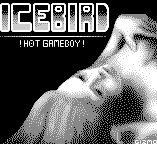 The
Gameboy was Nintendo's little handheld console released to the world at
the start of the 90s. Previously most handheld games had been fixed LCD
machines so the gameboy with its interchangable games, and sound could
easily be forgiven for only displaying shades of grey. Nintendo converted
several of their top NES titles, such as Mario land, Zelda and many
others, two gameboys could be linked together to play head to head games,
and the machine took off like no one had ever imagined it would! Gameboy's
took over the handheld gaming world, and even Sega's colour Game Gear with
far superior capabilities barely dented the gameboy's market. A super gameboy
was released with the ability to change the greys to set colours (although
this wasn't overly useful), and the gameboy underwent a re-release recently
when the pockey gameboy (same hardware, but thinner and lighter) was released.
Many peripherals have been created for the gameboy, such as digital cameras
and even a printer. Today, games are still being produced for the gameboy,
and you can still buy them in high street stores like Dixons. With technical
information about the gameboy being widespread these days, it has even
undergone a renaissance in the demo coding world. Demo competitions have
sprung up, allowing coders to show off what they can do on the powerful
portable. With the Colour Gameboy (which can also play all old gameboy
games) due out soon, there's a lot of life left in the gameboy yet!
The
Gameboy was Nintendo's little handheld console released to the world at
the start of the 90s. Previously most handheld games had been fixed LCD
machines so the gameboy with its interchangable games, and sound could
easily be forgiven for only displaying shades of grey. Nintendo converted
several of their top NES titles, such as Mario land, Zelda and many
others, two gameboys could be linked together to play head to head games,
and the machine took off like no one had ever imagined it would! Gameboy's
took over the handheld gaming world, and even Sega's colour Game Gear with
far superior capabilities barely dented the gameboy's market. A super gameboy
was released with the ability to change the greys to set colours (although
this wasn't overly useful), and the gameboy underwent a re-release recently
when the pockey gameboy (same hardware, but thinner and lighter) was released.
Many peripherals have been created for the gameboy, such as digital cameras
and even a printer. Today, games are still being produced for the gameboy,
and you can still buy them in high street stores like Dixons. With technical
information about the gameboy being widespread these days, it has even
undergone a renaissance in the demo coding world. Demo competitions have
sprung up, allowing coders to show off what they can do on the powerful
portable. With the Colour Gameboy (which can also play all old gameboy
games) due out soon, there's a lot of life left in the gameboy yet!
Gameboy 
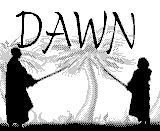 This was one of
the first gameboy emulators on any system, back in August 1995, being released
just 3 months after Marat Fayzullin's famous VGB for the PC. It was released
anonymously by the Purple Monchichi (for fear of reprisals from Nintendo),
and was warmly received by the whole Acorn community, as the first console
emulator for the Acorn. The emulator is single-tasking, and can either
be run on a one to one scale, pixel to pixel, or set to full screen mode
where the display is stretched to fit the screen (but this does slow the
emulation down somewhat). The compatibility is surprisingly good, and can
run most games, though the sound emulation is less than perfect, and some
games have distorted or even no sound (such as Choplifter 3 where music
is absent).
This was one of
the first gameboy emulators on any system, back in August 1995, being released
just 3 months after Marat Fayzullin's famous VGB for the PC. It was released
anonymously by the Purple Monchichi (for fear of reprisals from Nintendo),
and was warmly received by the whole Acorn community, as the first console
emulator for the Acorn. The emulator is single-tasking, and can either
be run on a one to one scale, pixel to pixel, or set to full screen mode
where the display is stretched to fit the screen (but this does slow the
emulation down somewhat). The compatibility is surprisingly good, and can
run most games, though the sound emulation is less than perfect, and some
games have distorted or even no sound (such as Choplifter 3 where music
is absent).
 Battery
backed RAM support is missing which is quite a shame since the wonderful
Zelda cannot be saved as it was meant to be. The super gameboy can also
be emulated and the different colours specified in a file inside the application,
though this is a hassle to adjust, and is best left alone. The emulator
has no support for two player options by emulating the link between two
gameboys, as has been done with emulators on other platforms, which is
a shame since two player gameboy tetris is superb.
Battery
backed RAM support is missing which is quite a shame since the wonderful
Zelda cannot be saved as it was meant to be. The super gameboy can also
be emulated and the different colours specified in a file inside the application,
though this is a hassle to adjust, and is best left alone. The emulator
has no support for two player options by emulating the link between two
gameboys, as has been done with emulators on other platforms, which is
a shame since two player gameboy tetris is superb.
Since it is tricky to configure the colours and the keys for Gameboy
(it involves looking up numbers and typing them in a text file), Rosemary
Miskin has written a few little utilities to allow these to be configured
in the desktop and saved to the emulator. She also has a small utility
called unRAR to decompress ROM images saved in this format, which
is written by Matt Aldridge.
Most interestingly, the source code to this emulator has now been released
for all to examine.
Gameboy v0.59 (3/10/98)
Speed Rating: ARM
2  ARM
3
ARM
3  ARM 6
ARM 6  ARM 7
ARM 7  StrongARM
StrongARM 
Gameboy
(44Kb ZIP file)
Andreas Stroiczek's
homepage
Rosemary
Miskin's utilities
Beercan's
gameboy pub - several colour tables for super gameboy
GBoyEm
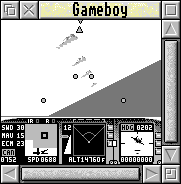 This
uses the same core emulator as Gameboy, but was hacked by Paul Clifford
in order to multi-task. The emulator is not strictly multi-tasking, as
although it plays games in a window on the desktop, it takes over the whole
machine until you press escape which pauses the emulation and allows use
of the rest of the desktop. Unlike the single tasking version, Paul's hack
works at perfect speed on a StrongARM, without the need for any patch.
Paul made the emulator easily configurable; super gameboy colours, key
presses, and control of the framerate can all be setup from an options
window.
This
uses the same core emulator as Gameboy, but was hacked by Paul Clifford
in order to multi-task. The emulator is not strictly multi-tasking, as
although it plays games in a window on the desktop, it takes over the whole
machine until you press escape which pauses the emulation and allows use
of the rest of the desktop. Unlike the single tasking version, Paul's hack
works at perfect speed on a StrongARM, without the need for any patch.
Paul made the emulator easily configurable; super gameboy colours, key
presses, and control of the framerate can all be setup from an options
window.
Extra functionality has also been added to the emulator, allowing battery
backed RAM to be saved and reloaded. The battery backed RAM is saved in
the same format as battery backed RAM saved by Marat Fayzullin's VGB for
the PC, for compatibility. Also Gameboy Game Genie functionality has been
added and it's codes can be entered to be used to cheat on the emulator.
These key features have vastly improved what was already a very good emulator,
but unfortunately for low end users, the emulation has slowed down an awful
lot, if you have an ARM3 or lower I suggest you stick to Gameboy, otherwise
this emulator has a lot more to offer.
Speed Rating:
ARM 3  ARM 6
ARM 6  ARM 7
ARM 7  StrongARM
StrongARM 
GBoyEm (60Kb
ZIP file)
GBoyEm Compatibility list
The Official
Galoob GameGenie page
Unofficial
Gameboy GameGenie page
Virtual GameBoy (VGB) 
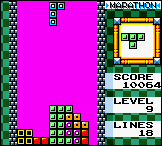 David
McEwen has ported Marat Fayzullin's infamous VGB to the Acorn. VGB
is infamous for several reasons; it was one of the first gameboy emulators
ever (even before the very early !Gameboy), it is also known as one of
the most compatible gameboy emulators around running nearly all gameboy
games, and it is also one of the most prolific having been ported to about
every modern platform in existence. Perhaps it's most momentous feature
is the Colour Gameboy emulation, and VGB is the first emulator to
support this on the Acorn.
David
McEwen has ported Marat Fayzullin's infamous VGB to the Acorn. VGB
is infamous for several reasons; it was one of the first gameboy emulators
ever (even before the very early !Gameboy), it is also known as one of
the most compatible gameboy emulators around running nearly all gameboy
games, and it is also one of the most prolific having been ported to about
every modern platform in existence. Perhaps it's most momentous feature
is the Colour Gameboy emulation, and VGB is the first emulator to
support this on the Acorn.
Other platforms versions even emulate the gameboy pocket camera and
pocket printer, though these are yet to be supported on the Acorn port.
Practically everything you can imagine a gameboy emulator wanting is present
in the VGB source code, and features are being added to the Acorn port.
It emulates every kind of gameboy imaginable, Pocket GB, Super GB, Colour
GB and even support for combined Colour & Super GB. At present, cheat
codes are supported, both GameShark and Game Genie, it also supports direct
MIDI output since at the moment there is no sound. As with most of David's
other ports, ZIP file support is present so that ROM images can be run
without being decompressed, in the format in which they're normally downloaded.
Save RAM is also supported for battery backed games, but at the moment
these files aren't compatible with !Gameboy - David's working on it.

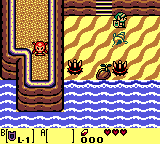
Above you can see Zelda before and after, the grey version is the original Zelda
ROM running on !Gameboy, the image on the right is the Colour Gameboy ROM
ZeldaDX running on VGB. In some cases the original gameboy game has just
been slightly adjusted, had the colour details added, and been re-released
as a CGB game - a bit cheeky of Nintendo, be a sensible consumer and leave
them on the shelves! A note for the uninitiated, Turok 2 is nothing like
the N64 version, it's just a dodgy platformer.
If you've got a StrongARM this is definately worth having a look, particularly
for ZeldaDX and TetrisDX, though you'll want !Gameboy if you like your
games with sound. For others, give it a go, but you'll probably be disasppointed
with the speed, but don't worry, I think some CGB games work ok under !Gameboy
(if the files aren't too large for it).
VGB v1.4 (6/1/99)
Speed Rating: ARM
3  ARM 6
ARM 6  ARM 7
ARM 7  StrongARM
StrongARM
Marat's VGB page
Gameboy Development Kit
Paul Clifford has ported Pascal Felber's Gameboy development kit to
the Acorn. This allows you to develop software for the gameboy in Z80 assembly,
or even C via the C compiler included if you prefer. Paul also wrote his
own little utility MakeTile, to compliment the Gameboy Development Kit.
MakeTile can be used to convert Sprites to Gameboy tiles suitable for use
with the GBDK.
The Icebird group have created their own (unreleased) Gameboy development
kit, with which they have created their HotGB demo, and it's follow up,
Dawn, which are very cool indeed, and available below.
GBDK (18/2/97)
RISC OS GBDK
(497Kb ZIP file)
MakeTile v0.04 (6/4/97)
MakeTile (6Kb
ZIP file)
RISC OS Gameboy
development kit page
Generic
Gameboy Development Kit page
Technical Information
CPU - modified 8bit Z80 (similar to Intel 8080) running
at 4.194304MHz
Display - 160x144 pixels, 40 sprites with 4 colours/sprite
(2.6" screen)
Sound - 2 channels, each with 4 methods of sound generation
RAM - 8Kb
VRAM - 8Kb
ROM - upto 2Mb
reference - kOOPa's updated version of Pan's document (25/9/97)
I believe the Colour Gameboy has a faster Z80 CPU, and can display upto
56 colours at anyone time. More specs anyone?
ROMS:
Hot Gameboy demo (15Kb ZIP file)
Dawn Gameboy demo (31Kb ZIP file)
Gameboy
ROMs
Gameboy
Gamez
Syko's
Gameboy Download site
Loads
of ROMs
Dutch
Gameboy ROM images (this site's a little tempremental)
Underground
Cities Gameboy ROMs
A
large list of ROMS
A small
but nice list of ROMs
Gameboy
emulation heaven (CGB ROMs)
GameGenie codes:
The Official
Galoob page
Unofficial
but still very large database
Some recommended ROMs:
Legend of Zelda, Mario 1, Mario 2, Tennis, Tetris, Micro Machines,
Toshinden, King Of Fighters 95, Worms,
Cool Spot, Final Fantasy III, ZeldaDX, TetrisDX.
The Acorn Emulation Page - David
Sharp
© Copyright David Sharp 1997,1998
Other interesting websites
 The
Gameboy was Nintendo's little handheld console released to the world at
the start of the 90s. Previously most handheld games had been fixed LCD
machines so the gameboy with its interchangable games, and sound could
easily be forgiven for only displaying shades of grey. Nintendo converted
several of their top NES titles, such as Mario land, Zelda and many
others, two gameboys could be linked together to play head to head games,
and the machine took off like no one had ever imagined it would! Gameboy's
took over the handheld gaming world, and even Sega's colour Game Gear with
far superior capabilities barely dented the gameboy's market. A super gameboy
was released with the ability to change the greys to set colours (although
this wasn't overly useful), and the gameboy underwent a re-release recently
when the pockey gameboy (same hardware, but thinner and lighter) was released.
Many peripherals have been created for the gameboy, such as digital cameras
and even a printer. Today, games are still being produced for the gameboy,
and you can still buy them in high street stores like Dixons. With technical
information about the gameboy being widespread these days, it has even
undergone a renaissance in the demo coding world. Demo competitions have
sprung up, allowing coders to show off what they can do on the powerful
portable. With the Colour Gameboy (which can also play all old gameboy
games) due out soon, there's a lot of life left in the gameboy yet!
The
Gameboy was Nintendo's little handheld console released to the world at
the start of the 90s. Previously most handheld games had been fixed LCD
machines so the gameboy with its interchangable games, and sound could
easily be forgiven for only displaying shades of grey. Nintendo converted
several of their top NES titles, such as Mario land, Zelda and many
others, two gameboys could be linked together to play head to head games,
and the machine took off like no one had ever imagined it would! Gameboy's
took over the handheld gaming world, and even Sega's colour Game Gear with
far superior capabilities barely dented the gameboy's market. A super gameboy
was released with the ability to change the greys to set colours (although
this wasn't overly useful), and the gameboy underwent a re-release recently
when the pockey gameboy (same hardware, but thinner and lighter) was released.
Many peripherals have been created for the gameboy, such as digital cameras
and even a printer. Today, games are still being produced for the gameboy,
and you can still buy them in high street stores like Dixons. With technical
information about the gameboy being widespread these days, it has even
undergone a renaissance in the demo coding world. Demo competitions have
sprung up, allowing coders to show off what they can do on the powerful
portable. With the Colour Gameboy (which can also play all old gameboy
games) due out soon, there's a lot of life left in the gameboy yet! This was one of
the first gameboy emulators on any system, back in August 1995, being released
just 3 months after Marat Fayzullin's famous VGB for the PC. It was released
anonymously by the Purple Monchichi (for fear of reprisals from Nintendo),
and was warmly received by the whole Acorn community, as the first console
emulator for the Acorn. The emulator is single-tasking, and can either
be run on a one to one scale, pixel to pixel, or set to full screen mode
where the display is stretched to fit the screen (but this does slow the
emulation down somewhat). The compatibility is surprisingly good, and can
run most games, though the sound emulation is less than perfect, and some
games have distorted or even no sound (such as Choplifter 3 where music
is absent).
This was one of
the first gameboy emulators on any system, back in August 1995, being released
just 3 months after Marat Fayzullin's famous VGB for the PC. It was released
anonymously by the Purple Monchichi (for fear of reprisals from Nintendo),
and was warmly received by the whole Acorn community, as the first console
emulator for the Acorn. The emulator is single-tasking, and can either
be run on a one to one scale, pixel to pixel, or set to full screen mode
where the display is stretched to fit the screen (but this does slow the
emulation down somewhat). The compatibility is surprisingly good, and can
run most games, though the sound emulation is less than perfect, and some
games have distorted or even no sound (such as Choplifter 3 where music
is absent). Battery
backed RAM support is missing which is quite a shame since the wonderful
Zelda cannot be saved as it was meant to be. The super gameboy can also
be emulated and the different colours specified in a file inside the application,
though this is a hassle to adjust, and is best left alone. The emulator
has no support for two player options by emulating the link between two
gameboys, as has been done with emulators on other platforms, which is
a shame since two player gameboy tetris is superb.
Battery
backed RAM support is missing which is quite a shame since the wonderful
Zelda cannot be saved as it was meant to be. The super gameboy can also
be emulated and the different colours specified in a file inside the application,
though this is a hassle to adjust, and is best left alone. The emulator
has no support for two player options by emulating the link between two
gameboys, as has been done with emulators on other platforms, which is
a shame since two player gameboy tetris is superb. This
uses the same core emulator as Gameboy, but was hacked by Paul Clifford
in order to multi-task. The emulator is not strictly multi-tasking, as
although it plays games in a window on the desktop, it takes over the whole
machine until you press escape which pauses the emulation and allows use
of the rest of the desktop. Unlike the single tasking version, Paul's hack
works at perfect speed on a StrongARM, without the need for any patch.
Paul made the emulator easily configurable; super gameboy colours, key
presses, and control of the framerate can all be setup from an options
window.
This
uses the same core emulator as Gameboy, but was hacked by Paul Clifford
in order to multi-task. The emulator is not strictly multi-tasking, as
although it plays games in a window on the desktop, it takes over the whole
machine until you press escape which pauses the emulation and allows use
of the rest of the desktop. Unlike the single tasking version, Paul's hack
works at perfect speed on a StrongARM, without the need for any patch.
Paul made the emulator easily configurable; super gameboy colours, key
presses, and control of the framerate can all be setup from an options
window.

